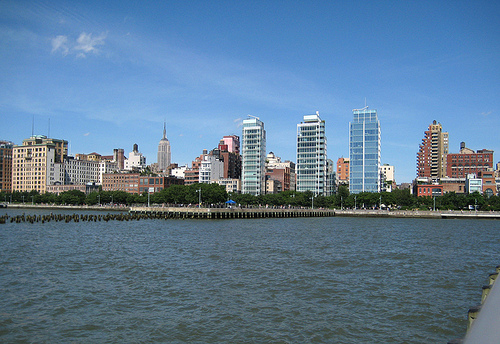BY DEBORAH J. GLICK | Downtown Manhattan and the West Side are awash in new development proposals that threaten the very nature of the most successful — and livable — of New York’s neighborhoods. The latest is a plan to construct high-rise luxury housing with 800 apartments at Pier 40, which will dramatically alter the Hudson River Park in precisely the way community residents rejected slightly more than a dozen years ago. The 1998 New York State legislation that created the Hudson River Park and its governing body, the Hudson River Park Trust, was the result of scores of public hearings, meetings and forums attended by thousands of community residents who raised their voices on this issue over a period of years.
At these public meetings, these New Yorkers expressed adamantly that their greatest need in these park-starved neighborhoods was an open waterfront park. Their greatest fear was that powerful real estate interests would overwhelm the community and construct luxury housing on the very desirable and profitable West Side waterfront. The core principle of the 1998 state legislation was to create a park that would forever maintain open access to the waterfront for everyone.
Ever since the Hudson River Park was created, there has been the oft-repeated mantra that the park is required to be self-sustaining — meaning that revenues within the park would have to cover all the costs of keeping the park in good repair. The actual language in the legislation (Chapter 592 of the Laws of 1998,) states, “It is intended that to the extent practicable and consistent with the intent of subdivision (c) of this section, the costs of the operation and maintenance of the park be paid by revenues generated within the Hudson River Park and that those revenues be used only for park purposes. Additional funding by the state and city may be allocated as necessary to meet the costs of operating and maintaining the park.”
There is no doubt that some of the physical structures in the Hudson River Park are in need of serious repair. Years of little maintenance, heavy use by park visitors and increased weather extremes have continued the process of aging parts of the park. However, the legislation never envisioned Hudson River Park needing to generate enough revenue to actually construct the park, which seems to be an implication of some of today’s discussions.
The original park plan designated some development nodes, and Pier 40 has certainly been one of the most productive locations throughout the park’s short history. Pier 40’s parking operation has generated 40 percent of the Park’s operating budget for years, while the much larger Chelsea Piers contributed 30 percent. Regrettably, the sweetheart deal concluded by a former governor has tied us to a less-than-generous contribution from Chelsea Piers for years to come. Pier 40 has lost some of its profitability, but a 2007 study by HR & A Advisors suggested that gross parking revenues of $13 million are achievable with monthly parking as a central feature, while at the same time preserving the playing fields that are crucial to our neighborhoods.
The recent “concept” of 15-story luxury housing at Pier 40 is projected to offer about $9 million to the Trust for operations, but would also include capital to stabilize the pier. The problem is that to build these mega-developments requires enormous funds to create the foundations necessary to carry the weight of these huge buildings that would irrevocably change the park and turn it into something we already have all over Manhattan: large buildings that block out air and light and, in this case, views of the water for the vast majority of those living in our neighborhoods.
Not yet discussed is how much of the park gets torn up to put in the necessary infrastructure — from sewer and water lines to utility lines — not to mention the actual construction of the buildings themselves. So there goes your park for at least a few years, if not longer. It’s not clear how much money the Trust gets during this time of construction, while the pier is largely a construction zone, or if anyone wants to be playing ball there then, or if that is even possible considering the liability issues that will be raised.
So this is why I have said we need to think this through carefully and rationally. And we have to have many more questions asked and answered about this proposal and any of the other legislative changes that the Trust is seeking. Years of experience, especially when it comes to the development of our most precious community resources, such as the jewel that is our waterfront, tells me that when we are presented with an ultimatum with an expiration date of six weeks, we need to be particularly vigilant.
Open space in New York City is the most valuable commodity we have. Once you lose it, you can’t get it back. That’s why we have to find a solution that balances the needs of the present with the responsibilities we have to future generations of New Yorkers.
Glick is assemblymember for the 66th District


















